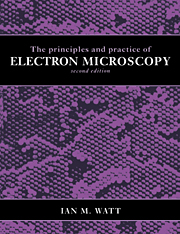Book contents
- Frontmatter
- Contents
- Preface to first edition
- Preface to second edition
- 1 Microscopy with light and electrons
- 2 Electron–specimen interactions: processes and detectors
- 3 The electron microscope family
- 4 Specimen preparation for electron microscopy
- 5 The interpretation and analysis of micrographs, pages 189 to 223
- The interpretation and analysis of micrographs, pages 224 to 262
- 6 Analysis in the electron microscope
- 7 Specialised EM- and other microscopical and analytical techniques
- 8 Examples of the use of electron microscopy
- Appendixes
- Bibliography
- Name index
- Subject index
8 - Examples of the use of electron microscopy
Published online by Cambridge University Press: 05 June 2012
- Frontmatter
- Contents
- Preface to first edition
- Preface to second edition
- 1 Microscopy with light and electrons
- 2 Electron–specimen interactions: processes and detectors
- 3 The electron microscope family
- 4 Specimen preparation for electron microscopy
- 5 The interpretation and analysis of micrographs, pages 189 to 223
- The interpretation and analysis of micrographs, pages 224 to 262
- 6 Analysis in the electron microscope
- 7 Specialised EM- and other microscopical and analytical techniques
- 8 Examples of the use of electron microscopy
- Appendixes
- Bibliography
- Name index
- Subject index
Summary
Introduction
In the fifty or so years since their commercial introduction electron microscopes have been used to study an ever-increasing variety of subjects. Nowadays, it is not unusual to see electron micrographs on television and in the popular press as well as in a wide range of periodicals and textbooks, even on postage stamps, illustrating subjects from abrasion to zoophytes.
The purpose of this part of the book is to mention some of the ways in which the instruments and technology which have already been described can be applied to practical problems in various fields and to illustrate a few of them. Some of the examples will be taken from the writer's own experience; the remainder have been provided by experts in other fields.
The basic techniques of specimen preparation and examination can be used, with suitable adaptation, for most examinations with the electron microscope. Working details can be found in a number of standard reference books, e.g. Kay (1965), Goodhew (1973 & 1985), Reid & Beesley, (1990), Hayat (1989a, b), Weakley (1981), Goldstein et al. (1992), and Robards & Wilson (1993). Variations on the standard themes can be found reported in the proceedings of national and international conferences on electron microscopy as well as scattered throughout the literature.
In a general survey it is convenient to divide the types of specimen into broad categories of particles, surfaces of various kinds, and thin films, foils and sections. There is biological and non-biological material in each category and it is hoped that every reader will find something in the chapter relevant to his or her own interests.
- Type
- Chapter
- Information
- The Principles and Practice of Electron Microscopy , pp. 334 - 378Publisher: Cambridge University PressPrint publication year: 1997

